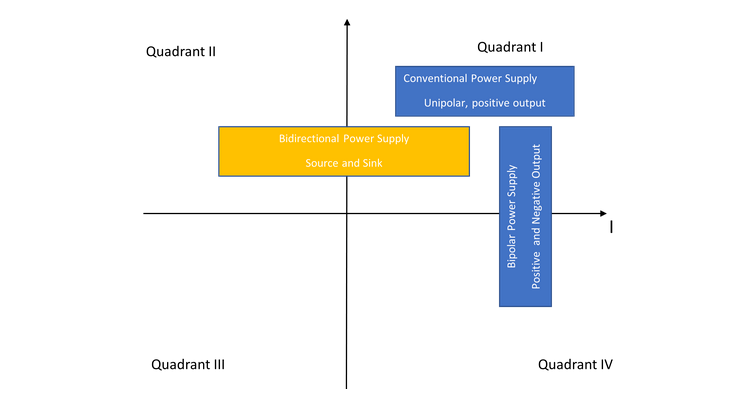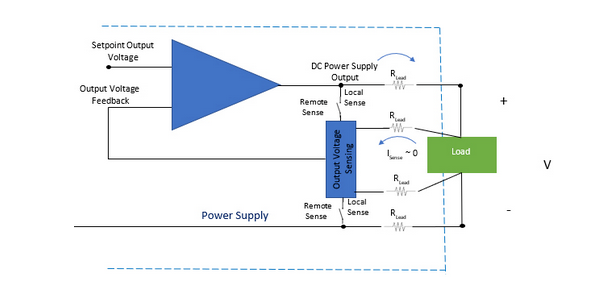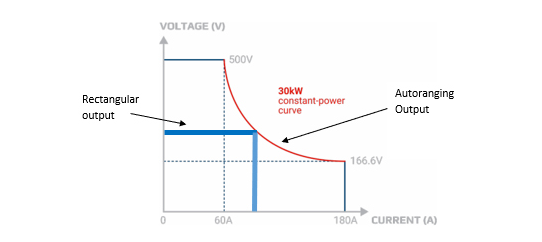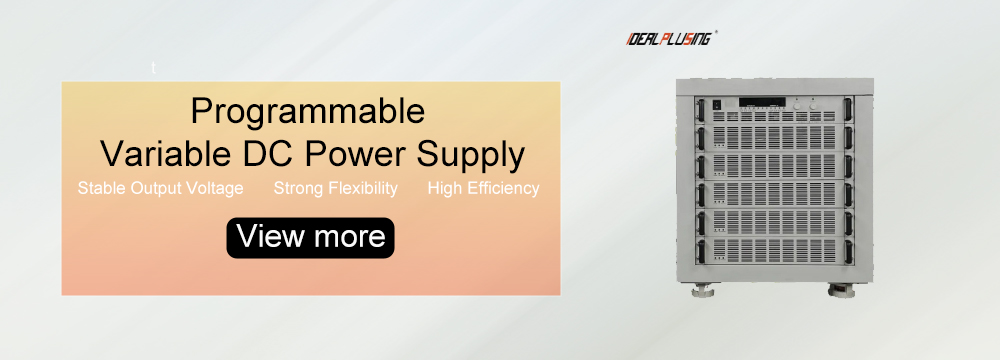An ideal DC power supply provides a constant DC voltage output regardless of load current. However, no electronic product or other similarly used device currently achieves the performance level described in electronics textbooks, where all designs are based on ideal components. So, how does a real power supply differ from a theoretical ideal power supply?

Before answering this question, let's take a look at how programmable DC power supplies actually work. There are many types of power supplies, and their specific functions are also different. Programmable DC power supplies have many applications in various industries. We will explore some of the characteristics of power supplies and see how these characteristics give power supplies rich functions to meet diverse application needs. In fact, seemingly simple products may contain complex technologies.
01 Overview of how power supplies work

Figure 1. Common modules of DC power supply
How it works
Figure 1 shows the basic circuit blocks of a DC power supply. The transformer electrically isolates the AC line from the rest of the circuit. The transformer also steps down or steps up the voltage of the AC line, depending on the required maximum DC output voltage that the power supply is expected to have.
The rectifier circuit block converts the AC voltage from the transformer to a unipolar AC voltage. Next, the filter block converts this unipolar AC voltage to a defective DC voltage with ripple effects.
The voltage regulator adjusts the output voltage to the required level and performs further filtering so that the output is a constant DC voltage.
These circuit blocks contain many components, but none of them are ideal. Capacitors and inductors have parasitic resistance, parasitic capacitance (in inductors), and parasitic inductance (in capacitors). Transistors and diodes have I-V characteristics that change with temperature. All components have tolerances in their parameter values, and they all consume power, have power limitations, and generate noise. These non-ideal characteristics prevent the power supply from being an absolutely constant DC output source.
02 Deviations from the Ideal Output
The output provided by a DC power supply is not always the output programmed by the user. The manufacturer will define the accuracy of a DC output as either output accuracy or displayed accuracy based on component tolerances. The manufacturer may also specify a temperature coefficient that is added to the output tolerance when the ambient temperature exceeds the power supply calibration temperature range. Another reason for the DC output to drop below the programmed value is that the internal resistance of the components in the power supply sees a greater voltage when a high current load is used. The manufacturer specifies this effect as load regulation, which is expressed as a percentage error of full voltage. To fully determine the output accuracy of a DC power supply, this load regulation error should be added to the output accuracy.
A DC power supply will also have noise on its DC output. All electronic components have inherent noise due to the movement and collision of electrons in metal structures. This noise is called Johnson noise. Noise is also generated in the power supply output due to conditions on the AC line, environmental electromagnetic interference (EMI), and stray currents on the ground line. As with other electronic instruments, minimizing noise in a power supply requires detailed knowledge of good design techniques. But no matter how good the design is, there will be noise on the output of the DC power supply.
03 Power Supply Topology
There are two types of power supply topologies. Power supply designs can be linear or switch-mode topologies. The difference in their design is the rectifier block and the voltage regulator block.
Linear Topology
In a linear design, current is constantly flowing through the circuit. The advantages of this design are low noise and low complexity, but the efficiency is not very high. Linear power supplies have an efficiency of less than 50%.
Switching Topology
On the other hand, switch-mode power supplies can have an efficiency of up to 90%, but they are much more complex and have much higher output noise. The reason for the higher noise is the active components, namely the transistors, which act as switches, turning the power supply on and off at kHz frequencies. The advantage of switch-mode power supplies is that they are smaller and lighter than linear power supplies of the same capacity. Switch-mode power supplies can be used with lighter and smaller transformers. In addition, the higher the switching frequency, the smaller the components of all inductive components can be.
While both topologies are suitable for power supplies up to a few hundred watts, switch-mode power supplies are mostly used to design power supplies with power levels exceeding 500 W, or even kilowatts. For kilowatt-class power supplies, the transformer will also be very large and very heavy.
04 Types of DC Power Supplies

Figure 2. Three Types of DC Power Supplies
Most power supplies are unipolar devices with a positive output. Both voltage and current are positive. They operate in only Quadrant I as shown in Figure 2. Power supplies can also have more complex circuits and operate in more quadrants. Bipolar output power supplies operate in Quadrants I and IV. The output voltage can be positive or negative, but the current is always positive. A third type of power supply can operate in Quadrants I and II. These are called bidirectional power supplies. In Quadrant I, the power supply is a DC voltage source. In Quadrant II, a bidirectional power supply has a positive voltage and a negative current. The power supply sinks current and acts as an electronic load. Therefore, a bidirectional power supply has the performance of both devices (a DC power supply and a DC electronic load).
05 Controlling the DC Output
Let's talk a little more about the voltage regulator circuit block. The voltage regulator filters the output to minimize the ripple of the DC output, while it also maintains the output voltage at a regulated or programmed level. We can model the voltage regulator circuit as a feedback amplifier, as shown in Figure 3 below. The output voltage sensing circuit monitors the output voltage and feeds it back to the power amplifier. The power amplifier's voltage output increases or decreases its output depending on the polarity of the voltage difference at the amplifier's input.

Figure 3. Power supply output stage showing voltage control (output filtering not shown)
When the current drawn by the load is low, it is sufficient to monitor the voltage at the output of the DC power supply. With low load currents, the voltage drop across the wires is not significant. However, with higher load currents, the voltage drop across the wires can be significant, and the voltage applied to the load will be lower than the programmed output voltage:
If the DC power supply is designed with a four-wire connection, where two wires are used to connect the power supply to the load and two wires are used to sense the load voltage, then correction can be made for the lower voltage at the load. Figure 4 below shows the four-wire connection for the load.

Figure 4. Output stage showing local and remote sensing
The output stage sensing circuit has a high input impedance, so the current drawn by this circuit is very small. When the voltage drop on the sense wires is negligible, the voltage sensing circuit measures the actual voltage at the load and feeds that voltage back to the power amplifier of the power supply. The amplifier increases its output voltage by two times the wire voltage to compensate for the wire voltage drop. This feature is called remote sensing and ensures that the output at the load is the desired voltage. In the absence of a 4-wire connection, the voltage regulator uses local sensing, that is, the output voltage is maintained at the voltage level at the output terminals. Using a 4-wire connection ensures greater load voltage accuracy.
06 Output Characteristic Options
Power supplies can use different methods to supply power to the load. A typical power supply will have a rectangular I-V output characteristic. The output of the power supply can be any combination of voltage and current values within a rectangular range bounded by the maximum rated voltage and maximum rated current. The thick blue line in Figure 5 below shows a DC power supply with a rectangular I-V output characteristic. The second power supply method is the auto-ranging output. A DC power supply with an I-V auto-ranging output characteristic has both rectangular and curvilinear output characteristics. The autoranging output feature provides a wider range of load currents and output voltages than a comparably capable power supply with a rectangular output. The black and red curves in Figure 5 are examples of the autoranging output feature. The benefits of the autoranging output feature include:

Figure 5. Comparison of rectangular and auto-ranging output characteristics
At all points on the red curve, full power is available. In contrast, a power supply with a rectangular output can only deliver full power at its maximum voltage and current (the rightmost corner of the blue rectangle).
At any voltage below the maximum voltage of a rectangular output power supply, the current delivered is greater than that of a power supply with a rectangular output.
With greater current output and voltage, a wider range of application needs can be met with greater flexibility. This may eliminate the need for additional power supplies and can be used for new or upgraded applications.
A lower power supply can achieve the same I-V performance as a rectangular supply, which can help save costs.
Some autoranging power supplies have a curved output characteristic that only delivers full power over a limited voltage range. EA Elektro-Automatik power supplies have a "true autoranging" output characteristic, which allows the power supply to deliver full power up to and down to 33% of the maximum rated voltage. Other autoranging power supplies are difficult to achieve this level of performance. This is what makes EA stand out from the crowd.
Therefore, the way a power supply delivers electricity determines its performance level.
07 Improving power supply performance
Power supplies can have other advanced features. Two examples are waveform generation and a variety of control interfaces. Power supplies can have built-in function generators for waveform generation based on DC bias. In addition, power supplies can have digital and analog interfaces for communication with PCs, PLCs, and other devices.
Bidirectional power supplies, when operating as a load, can convert the absorbed energy into AC power and feed it back to the AC grid with up to 96% efficiency. These types of power supplies are called regenerative power supplies.
In addition to providing an accurate and nearly pure DC voltage, power supplies can have more features as described above. With increased functionality comes increased design complexity.
08 Applications
Power Supply
Dc power supplies are used in most industries where electronic components are included in products. Design engineers rely on power supplies to develop new circuits and products. Test engineers rely on power supplies to verify the performance of finished products. In many industries that use electronic circuits and components, designs need to meet a wide range of power, voltage, and current requirements. Therefore, there are many power supply models to choose from, with outputs ranging from as low as 100 W to as high as 60 kW. These models range from benchtop supplies for designers to rack-mount supplies for test engineers.
Acting as a Simulation Source
In addition to powering, design and test engineers often need to simulate products such as solar panels, batteries, and fuel cells. This is when a bidirectional power supply with a built-in function generator can act as a simulation source to simulate a battery, battery charger, fuel cell, or solar panel. At the same time, this power supply can act as a load to simulate a discharged battery or the circuit that is powered by the battery, solar cell, or fuel cell.
The built-in function generator can simulate noise and other interference on the DC power line to verify that the product can withstand a certain level of stress. The function generator can also simulate waveforms to test compliance with specific standards, such as those in the automotive and avionics industries.
-Summarize-
DC power supplies are important equipment required for the design and testing of electronic products. The variety of electronic products has led to a variety of power supply types and power supply functions.
Source: German EA Power
The works reprinted and marked as from other sources on this website belong to the original copyright owner. The purpose is to convey more information, and does not mean that this website agrees with its views or confirms the authenticity of its content. It does not bear direct responsibility and joint liability for the infringement of such works. If there are any content, copyright and other issues of the work, please contact this website within one week from the date of publication of the work, otherwise it will be deemed to have waived the relevant rights.
This website is reprinted from other media or authorized to publish. If there are any content, copyright and other issues of the work, please contact us. For related cooperation, contribution, reprint authorization and other matters, please contact this website.
Share our interesting knowledge and stories on social media














